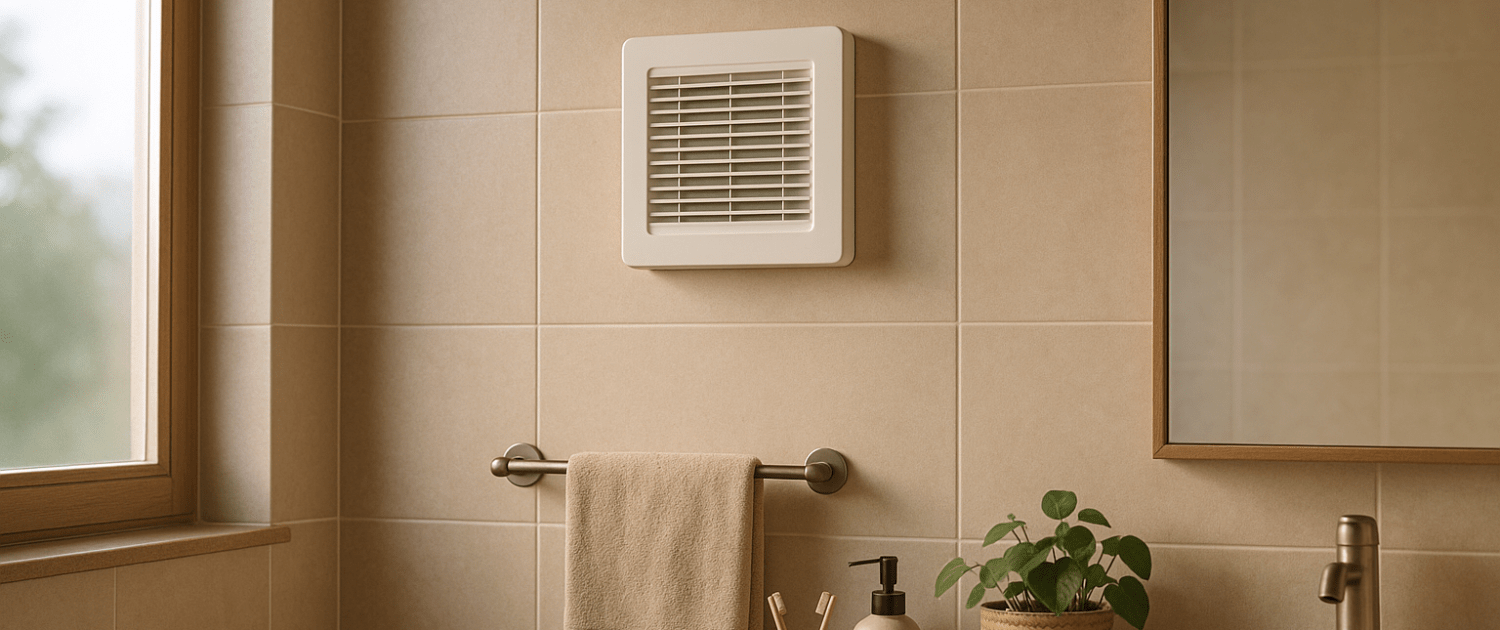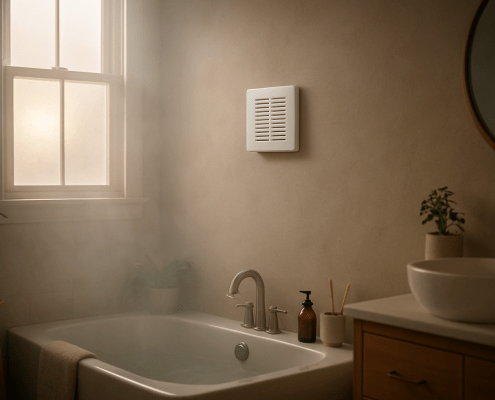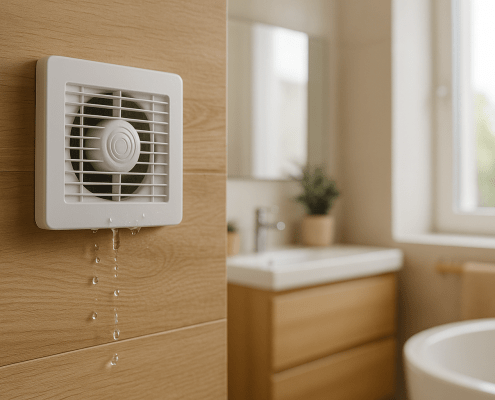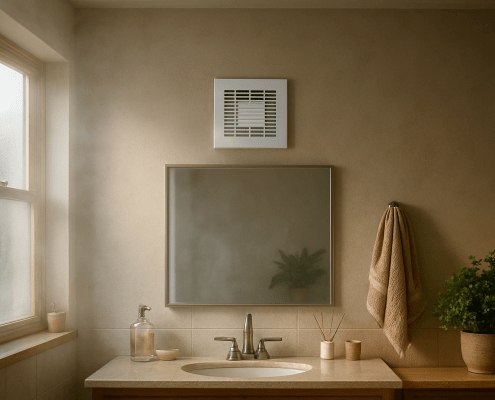Can a Bathroom Fan Be Too Powerful? Understanding High CFM
Steven E / Thursday June 26, 2025
When it comes to bathroom exhaust fans, many homeowners assume that bigger is better. A higher-powered fan must clear out steam faster, control humidity better, and leave your mirrors spotless every time you shower, right? Not quite.
While proper ventilation is critical in any bathroom, an overly powerful fan can actually create more problems than it solves. From energy inefficiency to negative air pressure and even damage to your home’s HVAC system, “CFM overkill” is a real concern.
If you’ve ever wondered whether your bathroom fan is too strong, or you’re in the process of choosing one and don’t want to make the wrong call, this guide is for you. Let’s break down what CFM really means, when a fan can be too powerful, and how to select the right one for your space.
The information in this article may not apply to your specific appliance model. We recommend consulting your manufacturer’s documentation or contact us with any questions.
What Is CFM and Why Does It Matter?
CFM stands for Cubic Feet per Minute, which measures how much air a fan can move in a given time. For example, a 50 CFM fan can remove 50 cubic feet of air per minute from your bathroom.
The general rule of thumb from the Home Ventilating Institute (HVI) and Energy Star is:
- 50 CFM for small powder rooms or half baths
- 1 CFM per square foot for standard bathrooms up to 100 sq. ft.
- Add 50 CFM for each additional feature: toilet, shower, bathtub, or jetted tub (for bathrooms over 100 sq. ft.)
So, a 10 ft. x 10 ft. bathroom with a toilet, shower, and tub should have a fan rated around 100–150 CFM.
It’s important to note that while a slightly stronger fan won’t hurt, going too far beyond your needs doesn’t provide additional benefits and can introduce new issues.
What Happens When a Bathroom Fan Is Too Powerful?
Choosing an exhaust fan with excessive CFM for your space might seem like a smart way to “upgrade” performance, but it can cause unintended consequences.
1. Increased Energy Consumption
A high-CFM fan draws more electricity than a lower-capacity model. If the fan is moving more air than necessary, you’re paying more in utility bills without gaining extra performance. Worse, if the fan runs longer than needed due to incorrect sizing, that inefficiency adds up over time.
2. Unwanted Noise
Many high-powered fans are louder than smaller units, especially if they’re not designed with sound-dampening features. A noisy fan can disrupt sleep or daily routines, particularly if the bathroom is near a bedroom or living space.
Even fans labeled as “quiet” may become irritating if they’re operating at full speed unnecessarily. Some models can be equipped with speed controls, but if you’ve already installed the wrong fan, this fix adds complexity and cost.
3. Negative Air Pressure
This is a major issue that often goes unnoticed. Powerful fans can pull air out of the bathroom faster than replacement air can enter. This creates negative pressure, which may result in:
- Backdrafting from combustion appliances like gas water heaters or furnaces
- Odors are being pulled in from other parts of the home
- Difficulty heating or cooling nearby rooms
- Air leaks through gaps in insulation, windows, or doors
In tightly sealed homes, especially modern energy-efficient builds, this can cause significant airflow imbalances that affect comfort and HVAC performance.
4. Poor Ventilation
It may sound counterintuitive, but a fan that’s too powerful can actually reduce ventilation efficiency. If the ductwork is not properly sized or routed, the high-speed airflow can create turbulence, increasing resistance and reducing the amount of air being exhausted.
This can cause moisture to linger, especially if the fan shuts off before the job is done, leaving you with foggy mirrors and a damp ceiling, despite the fan’s strength.
When a High-CFM Fan Might Be Appropriate
There are some scenarios where a more powerful fan is warranted:
- Large Bathrooms: If your bathroom is over 100 square feet or contains multiple fixtures, like a separate shower, toilet room, and jetted tub, you may need a fan rated at 150 CFM or higher. In these cases, stronger fans help ventilate air from corners and reduce the load on your HVAC system.
- Multiple Fans on One Switch: In some remodels, homeowners install more than one fan on the same switch (like a main fan and a shower-area fan). This setup requires a stronger unit or a combination of moderate ones to ensure proper airflow throughout the space.
- High-Ceiling Bathrooms: Tall ceilings add volume to the room, and the standard square footage calculation may fall short. For ceilings over 9 feet, you may need to factor in the added cubic volume when choosing a fan.
- Humid Climates: In areas with consistently high humidity, larger fans with humidity sensors can be beneficial, especially if the bathroom lacks windows or natural airflow. However, even in these cases, balance and proper ducting are critical.
How to Determine the Right CFM for Your Bathroom
Here’s a simple method for choosing the right fan size for most bathrooms under 100 square feet:
- Measure the length, width, and height of the room in feet.
- Multiply those together to find the total cubic volume.
- Divide that number by 7.5 (the standard air change rate for bathrooms).
For example:
An 8 ft. x 10 ft. bathroom with an 8 ft. ceiling = 640 cubic feet.
640 ÷ 7.5 = 85.3 → You’ll want a fan rated at around 80–90 CFM.
For larger bathrooms with multiple fixtures, use the fixture method:
- 50 CFM for each toilet
- 50 CFM for each shower or tub
- 100 CFM for a jetted tub
- Add these together for your target CFM rating
You can also consult product guidelines from the HVI or Energy Star, which provide detailed recommendations based on room layout and usage.
What to Do If You Already Have a Fan That’s Too Powerful
If your bathroom fan is noticeably too loud or causing pressure issues, don’t panic. You may not need to replace it right away.
Here are a few options:
- Install a variable-speed control to lower the fan’s output.
- Upgrade the ductwork to match the fan’s CFM rating.
- Add an air intake vent to balance pressure in the room.
- Replace the fan with a model better suited to your bathroom size.
In some cases, the issue may not be the fan’s CFM but poor ducting or installation problems that are making the fan seem more aggressive than it actually is.
Where To Find Us
If you need any replacement parts for your appliances, you can enter your model number at AppliancePartsPros.com to locate and order them quickly. Most orders arrive in just two business days, and we have tons of great information in our repair help section and YouTube videos to help you troubleshoot.
Stay connected with the latest DIY tips, tutorial videos, and repair guides by following us on Facebook, Instagram, and Twitter. We love hearing about your repair stories and successes. If you need more help or want personalized guidance, feel free to reach out. We’re ready to help you take on your next project with confidence!
With nearly a decade of experience in providing top-notch customer service regarding appliance parts and repair, Steven enjoys sharing practical advice, troubleshooting tips, and interesting information to help readers stay informed.





